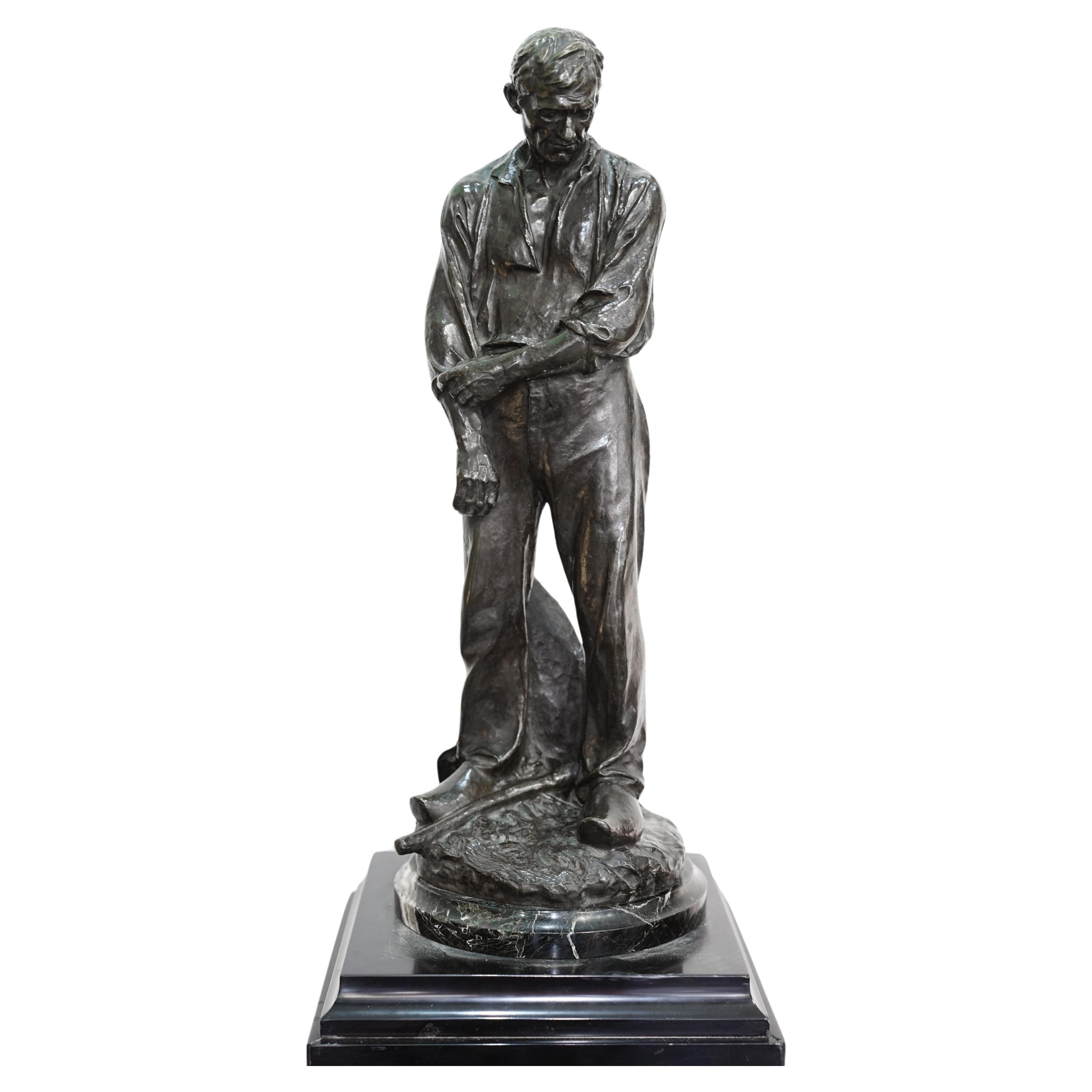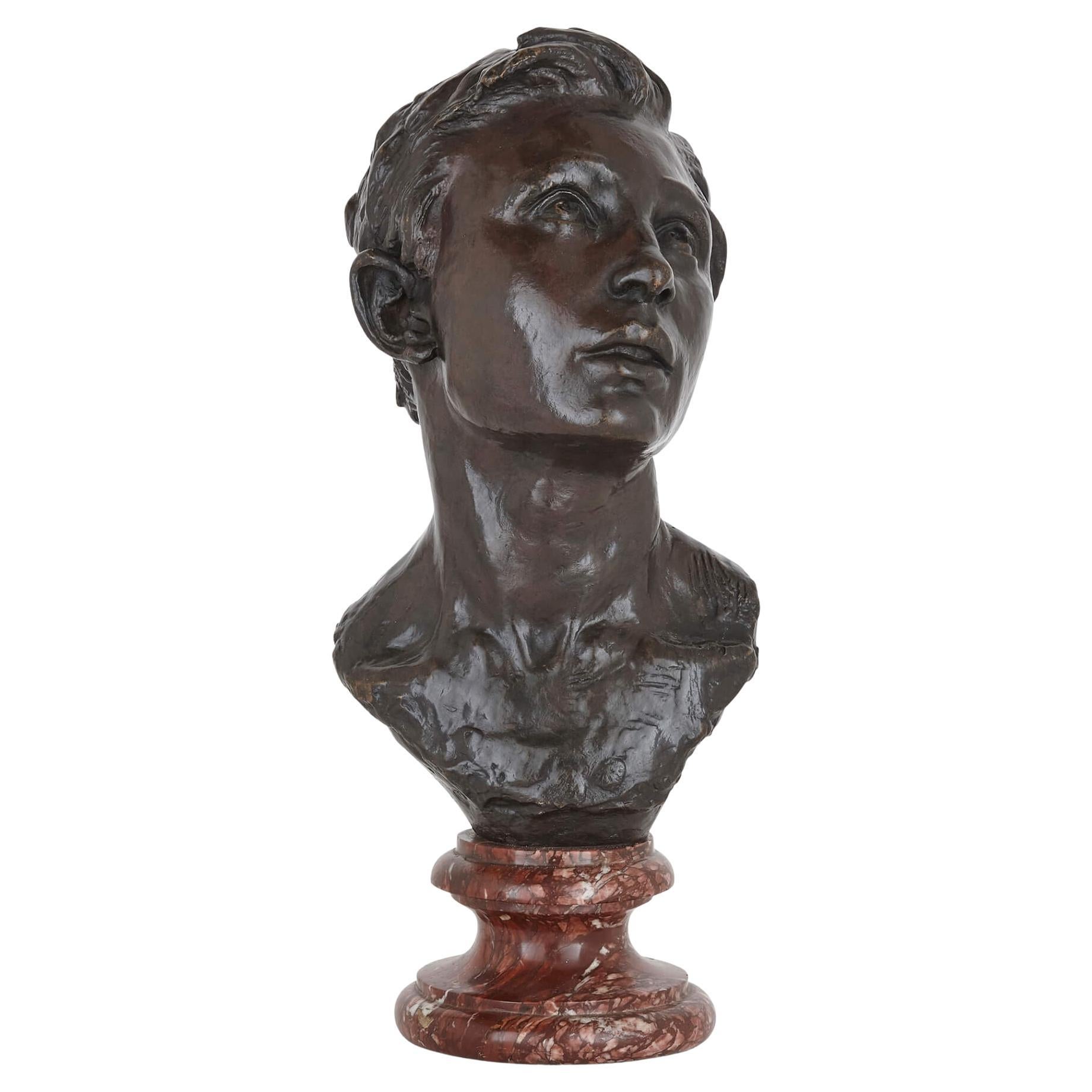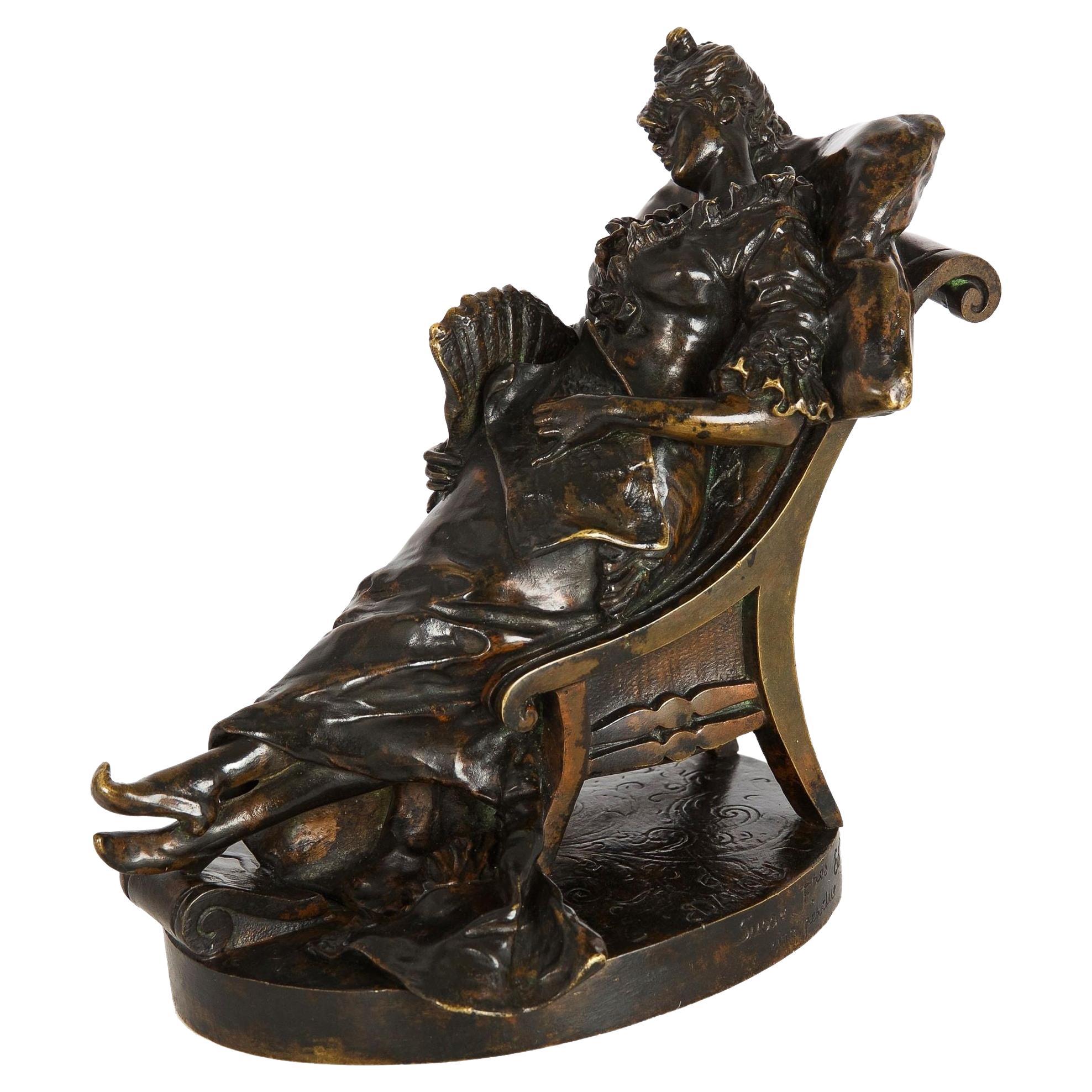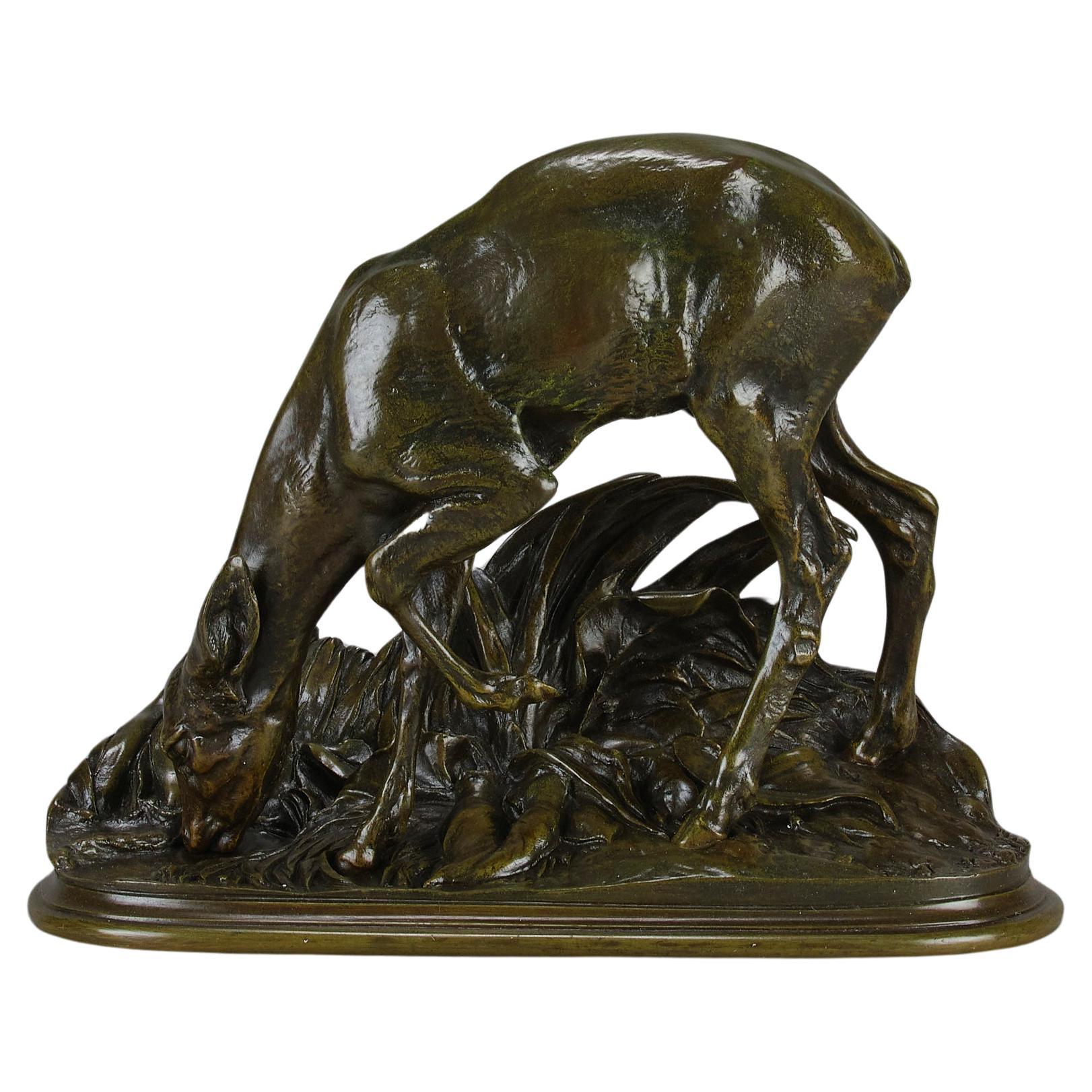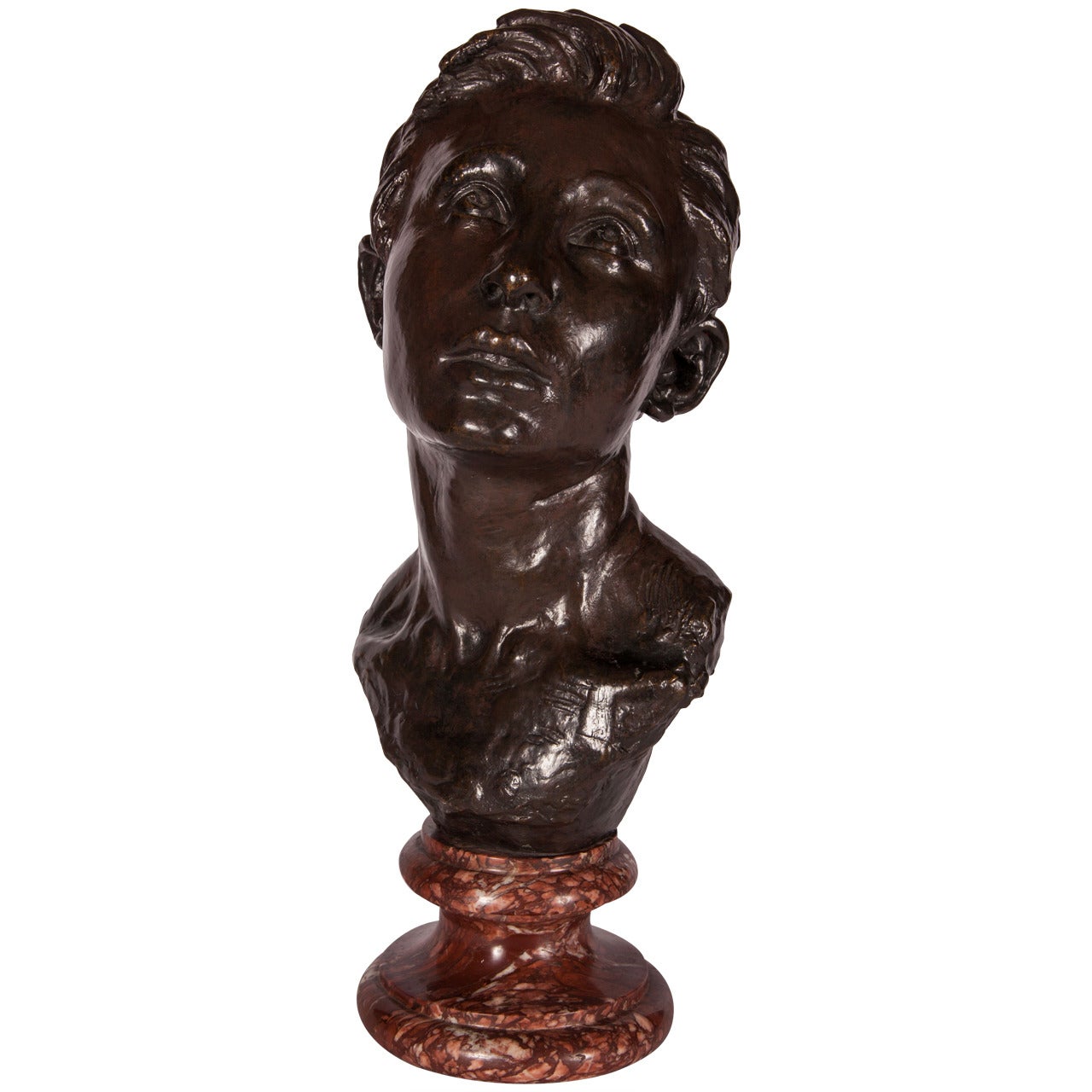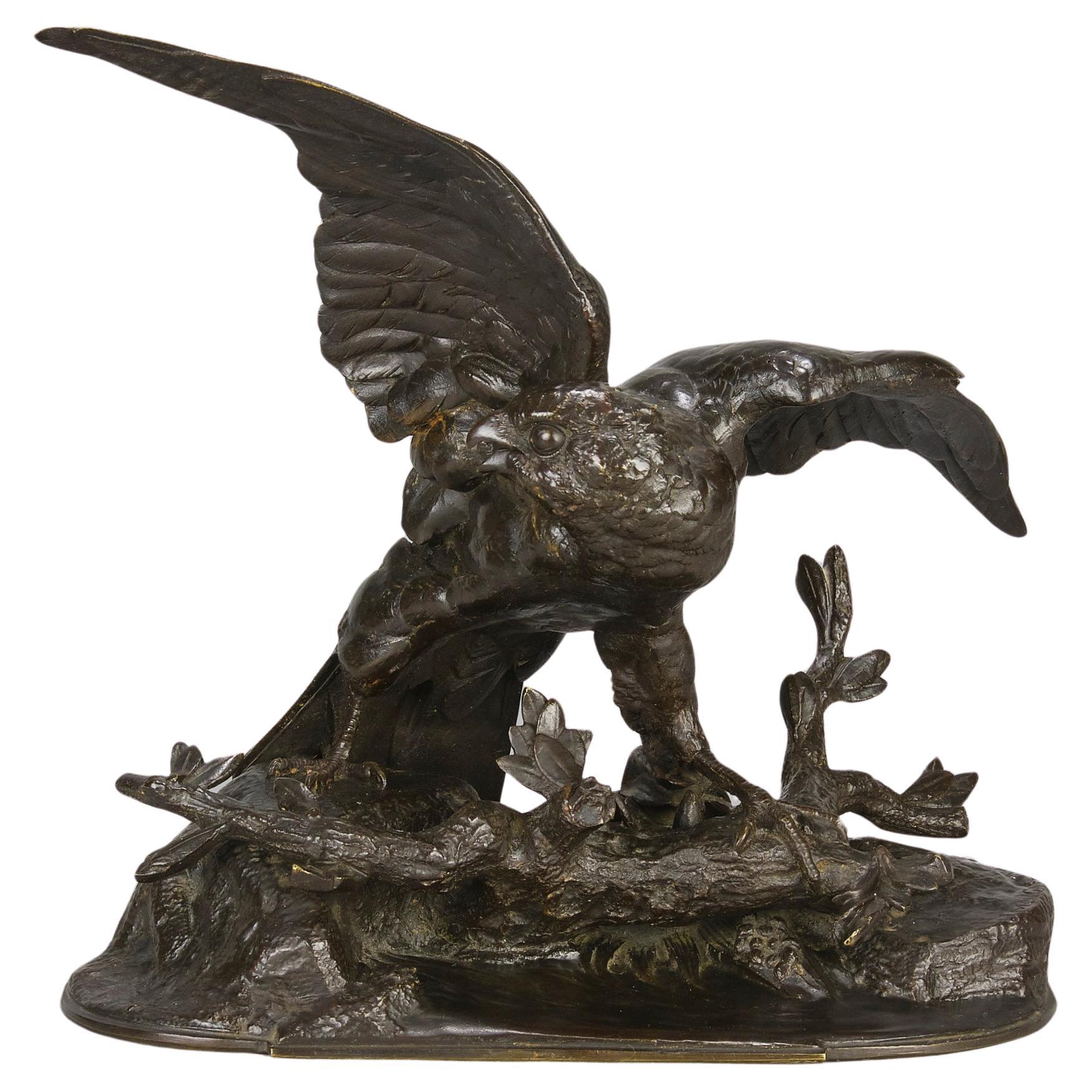Items Similar to Late 19th Century Bronze Entitled 'La Verité Meconnue' by Aime-Jules Dalou
Want more images or videos?
Request additional images or videos from the seller
1 of 11
Late 19th Century Bronze Entitled 'La Verité Meconnue' by Aime-Jules Dalou
About the Item
An enigmatic late 19th Century bronze study of a seated female nude leaning on her knees, hiding her face, on integral naturalistic canted rectangular base, signed to one side DALOU above the cracked mirror (facing to the rear), the opposing side marked Susse Fres Edts the rear with Susse Freres pastille flanked by the letters H P and S.
The title of this subject translates as 'The Truth Revealed' and refers to the young woman inconsolable having seen her true reflection in a mirror, which she has dropped and lies broken on the hard floor.
ADDITIONAL INFORMATION
Height: 14 cm
Width: 12 cm
Depth: 8 cm
Condition: Excellent Original Condition
Circa: 1890
Foundry: Susse Frères Paris
Materials: Bronze
SKU: 8790
ABOUT
Aimé-Jules Dalou (31 December 1838 – 15 April 1902) was a French sculptor, recognised as one of the most brilliant virtuosos of nineteenth-century France, admired for his perceptiveness, execution, and unpretentious realism.
He was born in Paris to a working-class family of Huguenot background, he was raised in an atmosphere of secularity and Republican socialism. He was the pupil of Jean-Baptiste Carpeaux, who sponsored him for the Petite École, where he sympathised with Alphonse Legros and Fantin-Latour. In 1854 he attended the École des Beaux-Arts de Paris in the François-Joseph Duret classroom. He combined the vivacity and richness of Carpeaux, for "he was, technically, one of the most distinguished modellers of his time", with the academic insistence on harmonious outlines and scholarly familiarity with the work of Giambologna, Pierre Puget, Peter Paul Rubens and others.
Dalou first exhibited at the Paris Salon in 1861, but he made no secret of his working-class sympathies. His politics obstructed his career under the Second Empire: he was repeatedly refused the Prix de Rome that opened sculptors' careers to future official commissions. He started to work for decorators, and through this work met Auguste Rodin and began their friendship. He made a quiet living providing decorative sculpture for the structures that lined Paris's new boulevards and providing wax models for jewelry. He married Irma Vuillier, a partnership that sustained him throughout his life; they had one daughter, Georgette, who was mentally handicapped and required constant care. Dalou's Daphnis and Chloe shown at the Paris salon of 1869, was purchased by the State.
Having identified himself too publicly with the Paris Commune of 1871, as curator at the Musée du Louvre under Gustave Courbet, he took refuge in England in July 1871, staying at first with his friend the painter and engraver Alphonse Legros. He rapidly made a name through his appointment teaching at the South London Technical Art School and the South Kensington School of Art, also in London. He was convicted in absentia by the French government of participation in the Commune, and given a life sentence.
In his eight-year English exile, Dalou's association with City and Guilds of London Art School, the National Art Training School and the artists of the New Sculpture movement laid the foundation for new developments in the post-classical British school of sculpture. He also recommended his friend and colleague Édouard Lantéri to move from France to England. At the same time Dalou executed a remarkable series of terracotta statuettes and groups, such as A French Peasant Woman and The Reader; a series of Boulogne women, such as A Woman of Boulogne telling her Beads; and a series of informal terracotta portrait busts of friends and acquaintances, rarely signed. He was commissioned to produce the large public fountain called Charity, erected at the back of the Royal Exchange (1878), and for Queen Victoria a monument to two young granddaughters in her private chapel at Windsor (1878).
He returned to France in 1879, after the declaration of amnesty, and produced a number of masterpieces. His great relief of Mirabeau replying to Dreux-Brézé illustrating an encounter of 23 June 1789, which was exhibited in 1883 and later at the Palais Bourbon, and the highly decorative panel Fraternity were followed in 1885 by The Triumph of Silenus. For the city of Paris he executed his most elaborate and splendid achievement, the vast monument, The Triumph of the Republic, erected after twenty years of work in the Place de la Nation, showing a symbolical figure of the Republic, aloft on her car, drawn by lions led by Liberty, attended by Labour and Justice, and followed by Abundance. It is somewhat in the taste of the Louis XIV period, ornate, but with a forward thrust to the ensemble and exquisite in every detail.
Dalou, who was awarded the Grand Prix of the Exposition Universelle (1889), was made a commander of the Legion of Honor. He was one of the founders of the Société Nationale des Beaux-Arts, and was the first president of the sculpture section.
Dalou died in Paris on 15 April 1902, aged 63, and was interred in the Cimetière du Montparnasse in Paris. His auction record, set at Sotheby's on 21 May 2014 is £362,500 for Boulonnaise Allaitant Son Enfant (a young mother from Boulogne feeding her child).
- Creator:Aimé-Jules Dalou (Artist)
- Dimensions:Height: 5.52 in (14 cm)Width: 4.73 in (12 cm)Depth: 3.15 in (8 cm)
- Style:Art Nouveau (Of the Period)
- Materials and Techniques:Bronze,Cast
- Place of Origin:
- Period:
- Date of Manufacture:1890
- Condition:Wear consistent with age and use.
- Seller Location:London, GB
- Reference Number:
About the Seller
5.0
Gold Seller
These expertly vetted sellers are highly rated and consistently exceed customer expectations.
Established in 1936
1stDibs seller since 2017
63 sales on 1stDibs
Typical response time: <1 hour
- ShippingRetrieving quote...Ships From: London, United Kingdom
- Return PolicyA return for this item may be initiated within 10 days of delivery.
More From This SellerView All
- Late 19th Century Animalier Bronze entitled "Biche Buvant" by Pierre Jules MêneBy Pierre Jules MêneLocated in London, GBA very rare mid 19th Century Animalier bronze study of a doe drinking by the side of a lake, the bronze with fabulous rich brown patina and very fine hand chased surface detail, rais...Category
Antique Late 19th Century French Art Nouveau Animal Sculptures
MaterialsBronze
- 19th Century Animalier Bronze Sculpture entitled "Falcon" by Jules MoigniezBy Jules MoigniezLocated in London, GBAn excellent mid 19th Century French Animalier bronze study of a falcon perched on a branch using its outspread wings to balance and with its beak open. The bronze exhibiting excellent intricate hand chased surface detail and very fine rich brown lightly rubbed patination, signed J Moigniez. ADDITIONAL INFORMATION Height: 23 cm Width: 23 cm Condition: Excellent Original Condition Circa: 1870 Materials: Bronze Book reference: Animals in Bronze by Christopher Paine Page no. 79 SKU: 9000 ABOUT Jules Moigniez (French, 1835 ~ 1894) Moigniez was a French animalier sculptor of the 19th century. He worked primarily in bronze and frequently exhibited his sculptures at the Paris salon. He was best known for his bronzes depicting birds, although his skill and versatility enabled him to produce quality horse sculptures (primarily racehorses), dog sculptures and hunting scenes. His bird sculptures were among the finest ever created in his time. Moigniez was born at Senlis, Oise, France in 1835, the son of a metal gilder. Moigniez’s father bought a foundry to cast his sculptures, which was of great benefit to Moigniez as he didn’t have the added foundry costs that most of his contemporaries had to pay. Moigniez studied sculpture under the tutelage of Paul Comoléra (a student of François Rude) in Paris. It is quite likely that Moigniez’s attraction to bird sculpture was a direct result of his education under Comoléra, who was himself a bird specialist. Over the course of his 40-year sculpting career Moigniez exhibited thirty works at the Salon between 1855–92. His first submission in a major art exhibition was his plaster, Pointer Stopping at a Pheasant, at the Exposition Universelle of 1855.[1][2] Moigniez was known for the fine detail and chiseling of his sculptures. His bronzes—usually cast using the lost wax method—were always immaculately chased and patinated, and were especially popular in England and Scotland.[2] More than half of his output during his lifetime was sold in the United Kingdom. By the end of the 19th century, his sculpture had become popular in the United States as well. In contrast with other animaliers of the period such are P.J. Mêne and Antoine-Louis Barye, Moigniez’s bird sculptures often incorporated highly detailed bases complete with bushes, extensive foliage and undergrowth. His castings were generally of excellent quality with a variety of patinas, the gilded and silvered patinas being the most desirable and sought after by collectors. His bronzes could be reproached for an excess of detail, a result of overly-finicky, over-worked chiseling. Moigniez received redemption, however, by portraying in his sculpture a certain “elegance of attitudes”. His Chien braque...Category
Antique Mid-19th Century French Art Nouveau Animal Sculptures
MaterialsBronze
- 19th Century Anamilier Bronze Entitled "Ewe And Lamb" by Pierre Jules MêneBy Pierre Jules MêneLocated in London, GBWonderful 19th Century animalier bronze group of a standing ewe with her feeding lamb beneath her, the bronze with excellent rich brown patina and very fine hand chased surface detai...Category
Antique 1870s Art Nouveau Animal Sculptures
MaterialsBronze
- 19th Century Animalier Bronze Entitled "Chien Et Pigeon" by Pierre Jules MêneBy Pierre Jules MêneLocated in London, GBExcellent quality and very rare mid 19th Century French Animalier bronze study of a seated griffon hound looking intently at two pigeons feeding beside him. The bronze with excellent...Category
Antique 19th Century French Art Nouveau Animal Sculptures
MaterialsBronze
- Late-19th Century French Animalier Bronze Entitled "Turning Whippet" by L MayerBy Louis MayerLocated in London, GBDelightful late19th century French Animaliers bronze study of a turning whippet looking around in an attitude to play, with rich brown colour and fine hand chased surface detail. Sig...Category
Antique 19th Century French Art Nouveau Animal Sculptures
MaterialsMarble, Griotte Marble, Bronze
- Late 19th Century Animalier Bronze entitled "Cheval Debout" by Isidore BonheurBy Isidore Jules BonheurLocated in London, GBMagnificent late 19th Century French Animalier bronze study of a standing thoroughbred with rich brown patina and excellent crisp surface detail, raised on a stepped integral base, s...Category
Antique Late 19th Century French Art Nouveau Animal Sculptures
MaterialsBronze
You May Also Like
- Aime Jules Dalou bronze sculptureBy Aimé-Jules DalouLocated in Buenos Aires, ArgentinaAime Jules Dalou bronze sculpture Realistic style bronze sculpture Circa 1900 Origin France Beautiful bronze sculpture called the great farmer lumberj...Category
Antique Early 1900s French French Provincial Figurative Sculptures
MaterialsBronze
- French Bronze Sculpture Bust of a Man by Aimé-Jules DalouBy Aimé-Jules DalouLocated in London, GBFrench bronze sculpture bust of a man by Aimé-Jules Dalou French, 1888 Measures: height 49cm, width 20cm, depth 21cm This fine patinated bronze bust b...Category
Antique 1880s French Busts
MaterialsGriotte Marble, Bronze
- Rare 1870s French Bronze Sculpture "Sleeping Woman" by Aimé-Jules DalouBy Aimé-Jules DalouLocated in Shippensburg, PAAIMÉ-JULES DALOU French, 1838-1902 A Sleeping Woman Patinated lost-wax cast bronze signed "DALOU" to base, inscribed "Susse Fres Edrs PARIS" and "cire p...Category
Antique 19th Century French Romantic Figurative Sculptures
MaterialsBronze
- Patinated Bronze Bust of a Young Man by Aimé Jules DalouBy Aimé-Jules DalouLocated in London, GBThe bust resting on a red marble waisted socle, inscibed to the reverse 'DALOU 1888'. Aimé Jules Dalou (French, 1838-1902) trained at the Petite E...Category
Antique 19th Century French Busts
MaterialsGriotte Marble, Bronze
- Late 19th Century Bronze Sculpture Entitled "Marquerite" Signed P. DuboisBy Paul DuboisLocated in New York, NYA wonderful late 19th century bronze sculpture entitled "Marquerite" Signed P. Dubois The bronze depicting a beautiful woman playing the harp. Paul Dubois was born on the 18...Category
Antique Late 19th Century French Belle Époque Figurative Sculptures
MaterialsBronze
- Late 19th Century Jules Meliodon Bronze-Mounted Vase, Louchet FoundryBy Jules Méliodon, Louchet FoundryLocated in Paris, FRGilt bronze sculptural vase by Jules Meliodon (French, 1867-after 1940), decorated with woman and satyr on a naturalistic background. Mounted as lamp and electrified. Signed Jules Méliodon and dated 1896. Marked Louchet underneath the base. Art Nouveau period. Exquisite embroidered lampshade...Category
Antique Late 19th Century French Art Nouveau Table Lamps
MaterialsBronze
Recently Viewed
View AllMore Ways To Browse
Cast Bronze Panel
19th Century Salon Set
Eight Panel 19th
Female Late 19th Century Artists
Presidents Politics
Gold Guild Furniture
French Empire Decorative Art
Seated Woman Sculpture
Empire Salon
Pierre Chapel
Bronze Large Ornate
Relief Sculpture Face
Antique Gold Rectangular Mirror
French Large Floor Mirror
Chloe Large
French 19th Century Ornate Mirror
19th Century English Windsor
Classroom Furniture Used
